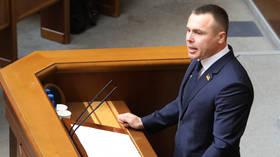Dwindling aid from West, total mobilization and economic collapse: How Ukraine’s 2024 is looking
Waning Western support, heavy losses and lack of battlefield gains have apparently hugely dented the hopes of Kiev and its backers
Ukraine is heading towards 2024 with mounting battlefield casualties, a lack of tangible military progress, the now-official failure of its counteroffensive efforts, its ever-widening conscription drive, as well as a shrinking flow of financial and military aid from its Western backers.
The country’s prospects for the next year now look rather grim, with what were once the most ardent supporters of Kiev now apparently unsure whether aid to the country locked in a nearly two-year conflict with Russia should continue.
Tough winter to come?
Multiple officials have voiced fears that Moscow may opt to launch a new campaign against Ukraine’s critical infrastructure similar to the one it conducted during the previous winter season.
Ukrainian officials have provided conflicting accounts of the extent of damage to infrastructure and of progress in fixing it. Nearly 60% of the country’s power generation and some 43% of the entire high-voltage network ended up damaged last year, according to state-owned operator Ukrenergo. Ukraine’s Prime Minister Denis Shmygal, however, said 40% of the “electricity infrastructure, including generation and power grid,” was destroyed, with “most of this damage” fixed.
So far the Russian military has seemingly abstained, however, from staging a concentrated campaign against Ukraine’s critical infrastructure, apparently focusing its long-range attacks on rear facilities such as ammo dumps, airfields and anti-aircraft defenses.
Western support on the wane?
Ukraine’s top donor, the US, was unable to adopt a new lavish aid package for the country, with Congress shelving the issue after its holiday break. Despite acknowledging the fact that Kiev was now “almost totally reliant on Western assistance for artillery and rocket artillery systems and ammunition,” the legislators failed to agree on it after weeks of back-and-forth, with the Republican opposition insisting Washington should focus on domestic issues instead. Now the US has effectively run out of cash for Ukraine, with State Department spokesperson Matthew Miller admitting last week that no “magic pot” of funding existed.
Another of Kiev’s major backers, the EU, has found itself in a deadlock over the Ukraine aid package as well. The long-debated tranche of €50 billion (some $55 billion) ultimately ended up being vetoed by Hungary in mid-December, with its next chance for approval pushed into next year.
Should no foreign aid arrive, it will be a “disaster” for Ukraine, Maksim Skripchenko, the president of the Transatlantic Dialogue Center, a Kiev-based think tank, has said. The expert, however, expressed hopes the aid will ultimately be approved by the donors, though he warned that “with every week, the chances of this happening are decreasing.”
“In a month or two, we will be not able to defend ourselves against Russian missiles. We will not be able to conduct huge military operations. More than one month is a real problem,” Skripchenko told The Hill last week.
Economic hardships to get worse
The shrinking Western aid might make Ukraine not only unable to sustain its war effort but actually result in the collapse of the country’s whole economy. It is expected to be able to weather the next few months but, without adequate external funding, Kiev will be unlikely to be able to plug next year’s massive $43-billion budget deficit.
“The government has a liquidity reserve for January and February,” said Yury Gayday, a senior economist with the Centre for Economic Strategy, a Kiev think tank, told Reuters last week.
In addition to closing the budget gap, Kiev also needs to find ways to restructure about $20 billion in international debt after foreign bondholders agreed in mid-2022 to freeze due payments for two years. Still, the country’s Finance Minister, Sergey Marchenko, has said the country “hoped” to secure foreign funding, though he admitted “the scenario will include the need to adapt to new conditions” should the conflict continue to drag on.
Total mobilization looming?
Kiev has maintained its increasingly violent and lawless conscription drive since the early days of the conflict, with the effort apparently intensifying in recent months in order to compensate for heavy battlefield casualties. Now, it is seeking to mobilize an additional 500,000 people, with the top officials apparently trying to shift responsibility for the expanded recruitment drive.
Ukrainian President Vladimir Zelensky has claimed the figure was floated by the military, while the country’s top general, Valery Zaluzhny, disputed the claim, stating that command has not actually requested any exact numbers but a steady supply of recruits to meet its manpower needs to fill shortages.
Defeat for the West?
The most hawkish supporters of Ukraine, however, continue to insist that aid to the country must flow, warning that its potential loss would actually become a defeat for the collective West. NATO Secretary-General Jens Stoltenberg, for instance, has repeatedly said such an outcome would constitute “a defeat for us all.”
A similar opinion has been voiced by the former Chairman of the NATO Military Committee and incumbent President of the Czech Republic, Petr Pavel, who argued that anything but a complete defeat of Russia would be a failure for the US-led bloc. The scenario of Ukraine gaining the upper hand militarily, however, was unlikely, he admitted.
“Time now favors Russia, which has a stronger base to mobilize human resources,” Pavel said in November. “Any success for Russia will mean our failure.”







Comments are closed.